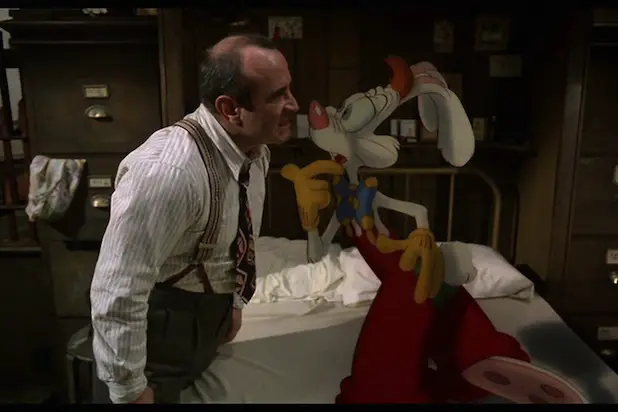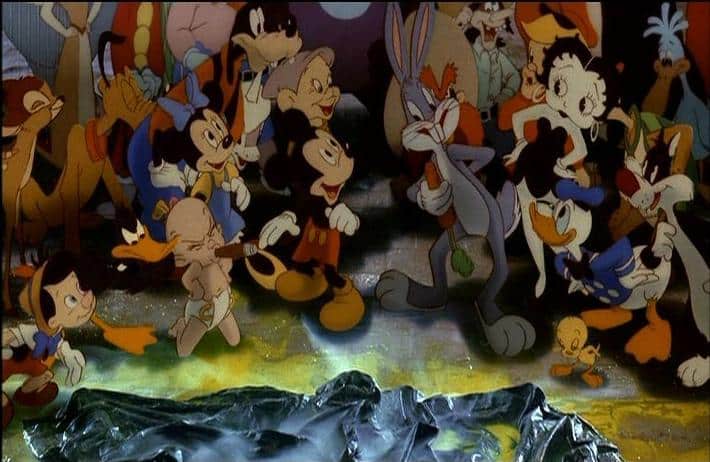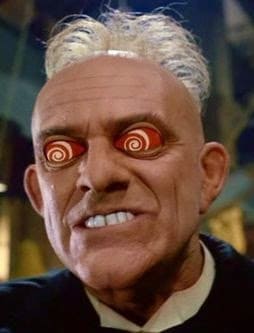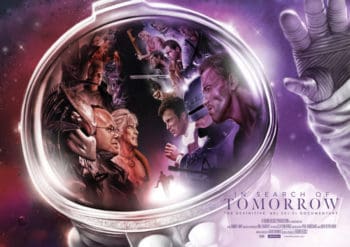
“Avengers: Endgame is the most ambitious crossover event in cinematic history…”
Who Framed Roger Rabbit: “hold my beer…”
That first sentence was in reference to the juggernaut that is, of course, The Avengers, End Game, and everything to do with the MCU. As great a triumph as the movie has been, a Robert Zemeckis live-action/animated movie from 1988 probably takes the cake.
This article is a look back on Who Framed Roger Rabbit, how it all came together, and why we will never see a movie like this again.
Ever.
Setting The Stage For Who Framed Roger Rabbit
I hope to hell you’ve seen this movie but if you haven’t, pause your reading and do what you can to go watch it. Who Framed Roger Rabbit came out in 1988 and as mentioned, was directed by the great Robert Zemeckis.
Many people don’t know this but the movie is actually based on a book from 1981 called Who Censored Roger Rabbit? It was a mystery novel written by Gary K. Wolf and I had no idea that this thing ever existed. The main elements are there including Eddie Valiant as the detective and Roger Rabbit as the main character. The big difference in this book is that Roger ends up being murdered. BUT, Roger had created a doppelganger that was in on this and another murder, and a genie from a magic lamp intervenes.
Ya, it’s a bit different from the movie…
Anyhoo, the book would still be the basis for the movie as all the main characters are in it. The book, however, is set in the modern-day and Who Framed Roger Rabbit would partly be looking at the glory of old Hollywood.
The Plot Of Who Framed Roger Rabbit
The basic plot follows the story of the characters of ToonTown who live amongst real-life humans. Roger Rabbit is a top star but has been having lackluster reviews as of late which is making R.K. Maroon – head of Maroon Cartoons – pretty nervous. Eddie Valiant is brought in to check up on Roger’s smoking hot wife, Jessica, as she’s thought to be romantically involved with Marvin Acme who owns the Acme Corporation and Toon Town itself.
Marvin is found dead and it looks like Roger did it. We meet Judge Doom and his team of weasels who are charged with trying to track down Roger and bring him to justice. Judge Doom is inherently sinister and has created something called “dip” which can kill a toon.
It’s thought that Roger may be innocent and that Marvins will – which had been lost – was going to give the toons the right to owning ToonTown. We find Roger hiding out in Eddies’ office swearing that he’s innocent. We find out that Maroon Cartoons is being sold to Cloverleaf that runs the transportation system in town, and had bought the trolly network before Marvin was murdered.
R.K. Maroon had blackmailed Marvin to sell his company so he could sell the studio. Maroon is killed and isn’t able to share the details of the will. We find out that Doom killed Marvin, and Maroon and in the Acme factory Doom shares his plan to destroy Toon Town, melt it with Dip, and build a freeway (mirroring what would end up happening in Los Angeles).
Eddie battles Doom who is actually a toon and the one that killed Eddie’s brother. Doom is killed and everyone lives happily ever after.
Creating The Movie
Disney had been on board with this as a film since the book came out and had purchased the movie rights in 1981. Amblin Entertainment and Steven Spielberg were brought in to produce the movie alongside Zemeckis who would direct it. Fellow Canuck Richard Williams would be in charge of all the animation.
The making of this movie was a massive undertaking from a technical standpoint as well as a legal one. Disney had been testing footage as early as 1981 but nothing was coming together until Michael Eisner overhauled things in 1985. To do it right, Eisner said, it was going to cost $50 million which today would be around $120 million.
This seems like nothing based on how much films cost to make today but back then things were a bit different. In 1985 you only just had the Star War franchise, Back to the Future 1 had just come out, Indiana Jones was underway, and they’re just wasn’t the massive entities we have today. Today, studios know they have to invest more money than ever to at least break even and make a profit. Unless you’re a Marvel movie, there’s no guarantee that a film will be a hit.
Disney of course now owns everything so they can put half a billion into a movie and afford to take the hit if it’s not successful. Back then, it was unwise to invest too much.
Eventually, they got the budget down to $30 million, but that still made it the most expensive animated film of all time.
Who Framed Roger Rabbit Cast
Let’s take a look at the human and cartoon cast, shall we?
- Bob Hoskins played Eddie Valiant
- Christopher Lloyd played Judge Doom (I can’t think of any other notable roles he had…)
- Stubby Kaye was Marvin Acme
- Joanna Cassidy was Delores (also the replicant Zhora in Blade Runner)
- Alan Tilvern was R.K. Maroon
- Kathleen Turner voices Jessica Rabbit (and was uncredited for some reason)
- Lou Hirsch voiced Baby Herman (he was also Fred in Superman III)
- Charles Fleischer as Roger Rabbit, Benny The Cab, Greasy, and Psycho (Fleischer also appeared on Hill Street Blues, A Nightmare on Elm Street, and was Terry in Back to the Future 2 – The “thumb a hundred bucks” to save the clock tower guy)
- The Great Mel Blanc voiced: Bugs Bunny, Daffy, Porky Pig, Tweetie, Slyvester (this was his last real role before passing away)
- Joe Alaskey voiced Foghorn Leghorn and Yosemite Sam
- Wayne Allwine as Mickey Mouse,
- Tony Anselmo voiced Donald Duck (but they used old recordings of original voice Clarence Nash as well)
- Tony Pope voiced Goofy
- Mae Questel was back as her iconic Betty Boop (Questel was also Aunt Bethany is Christmas Vacation)
- A young Nancy Cartwright aka Bart Simpson was the voice of that toon shoe
- Cherry Davis was Woody Woodpecker
As notable as all these actors and performers are, it’s just as interesting to see who DIDN’T end up with roles in the film. Harrison Ford was the original choice to play Eddie but he was charging too much for it. They then considered Bill Murray but Murray wasn’t always quick to take up offers for roles and ended up missing out. I could have seen both of them easily as Eddie too.
Most surprisingly, Eddie Murphy actually turned down the role. I can’t even imagine what this movie would have been like with him playing Valiant. Also being considered: Basically all the best actors you can think of including Sylvester Stallone, Chevy Chase, Robert Redford, Robin Williams, Jack Nicholson, Ed Harris, and Charles Grodin.
Holy crap.
Tim Curry was up for the role of Judge Doom which also would have been perfect. Zemeckis was obviously comfortable with Christopher Lloyd after Back to the Future (Back to the Future! That’s where I remember seeing him!). Apparently the producers turned down Tim Curry as he was considered too terrifying for the role of Doom. First of all, what the hell, and second – that seemed like the whole point of the character. They also considered Christopher Lee (who would have been perfect) John Cleese, Roddy McDowall, and I’m not making this up – Sting.
Christopher Lloyd really was perfect as he does have this zany, cartoon-like sensibility to him. Also, if you watch the movie again, notice that Lloyd never blinks in any scene. Ever. This was his way of perfectly encompassing who the character was and that he was part toon and part mad man (but not the handsome Don Draper type).
Characters In Who Framed Roger Rabbit

There are a crapload in this movie, and we covered some of the main ones in the cast, but here are some of the big characters specifically from Disney and Warner Bros and some from smaller studios.
Disney
- Mickey and Minnie Mouse
- Donald and Daisy Duck
- Goofy
- Pluto Pete
- Huey, Dewie, and Louie
- Horace Horsecollar
- Clarabelle Cow
- Characters from The Merry Dwarfs, Flowers and Trees, Fathers Noah Ark
- Clara Cluck
- Gus Goose
- Big Bad Wolf, Little Red Riding Hood, Fiddler Pig, Fifer Pig
- All the characters from Snow White
- Various characters from Fantasia
- All the characters from Dumbo
- Bambi, Thumper, The Great Prince, Faline, and Flower
- Chicken Little
- Piglet
- The Penguin Waiters from Mary Poppins
- Peter Pan, Tinkerbell, John Darling
- Flaps the Vulture and Kaa from the Jungle Book
Warner Bros.
- Bugs Bunny
- Daffy
- Elmer Fudd
- Porky Pig
- Yosemite Sam
- Tweety Bird and Sylvester
- Foghorn Leghorn
- Road Runner and Wile E. Coyote
- Marvin the Martian
- Sam Sheepdog
- Speedy Gonzales
From other studios:
- Betty Boop
- Droopy
- Spike
- Koko the Clown
- Woody Woodpecker
- Gandy Goose
- Looey Lion
- Felix the Cat
The Success Of The Movie
I don’t have to tell you what a big hit Who Framed Roger Rabbit was – but I’m still going to. It came out on June 22, 1988, and was immediately a massive hit – commercially and critically. It won three Academy Awards and would make $156 million domestically and $329 million overall. Converted for today that’s $340 million and $713 million respectively.
Those are pretty good numbers even by today’s standards. It’s also worth pointing out that movies were shown in fewer theatres. Who Framed Roger Rabbit appeared on just 1045 screens compared to the 3000 to 4000 you might have with a Marvel movie.
The movie was an animation spectacle and still did old-school animation on hand-drawn cels. It was also seen as creating a massive interest in traditional animation and helped put in movement the new era for Disney animation that would bring modern classics such as The Little Mermaid, Beauty and the Beast, Aladdin, and The Lion King. This is the era which is considered the “Golden Age” of animation.
Yep, if it wasn’t for the success of Who Framed Roger Rabbit, none of those movies would have ever happened.
Who Framed Roger Rabbit would end up being the second-highest grossing movie of 1988 finishing behind Rain Man and, at that point, was the 20th highest-grossing movie of all time.
How Did They Get All These Characters Into One Movie?
If it wasn’t for Steven Spielberg, this movie never would have happened. The man is such a Hollywood powerhouse, influencer, and convincing (actually all three combined) that he was able to convince all the other studios to lend their characters to the movie.
This just would not happen today as each property, or character, has the potential to be its own entity and money maker. You don’t want to risk out on someone else making money off it and there is no better example of this than with Spider-Man. Sony has owned the rights to Spider-Man and only lent him to Marvel (and now Disney). With the massive success of the Avengers movies and the standalone Spider-Man ones, there is just too much value in the character to let someone else profit off it.
Sony has taken back the usage of Spider-Man for their own projects and not allowing him to appear in future Marvel movies (at least for the time being). There’s a good chance they could destroy all the work that has been done by Marvel, Disney, and Tom Holland, but they’re willing to take that risk.
In the case of Who Framed Roger Rabbit, these concerns were not at the forefront. There was no such thing as billion-dollar movies and the loaning of characters seemed to have more of a neighborly quality to them — like borrowing a cup of sugar. Spielberg was able to convince the following to lend their characters:
- Warner Bros – all of the Looney Tunes characters
- Fleischer Studios – Koko the Clown, Betty Boop, Popeye, Superman
- King Features Syndicate – (also had the rights to Fleisher characters)
- Turner Studios – Droopy, Spike, Meathead Dog, Benny Burro
- Universal/Walter Lantz Productions – Woody Woodpecker, Papa Panda, Willy Walrus, Chilly Willy, Dinky Doodle
- Felix The Cat Creations
- Paramount Pictures – The Joker
These studios must have thought this was good exposure and they didn’t have to do any work. There may have been more motivation for Spielberg to get all these rights as he was to get a large part of the box-office profits. He also made sure his contract gave him a huge amount of creative control, so he could use these characters that could help make the movie an even bigger success.
The Characters They Couldn’t Get
Spielberg and Disney didn’t get rights to everything (even though it seemed that they did) and there were plenty of characters they couldn’t lockdown. Here’s a list of characters that were either unavailable or were written into the movie and cut from the final version:
Disney
- Chip and Dale
- Br’er Rabbit
- Br’er Fox
- The Pied Piper
- Vultures from Snow White
- Ichabod Crane
- Characters from Fantasia
Warner Bros
- Pepe le Pew
- Petunia Pig
- Tasmanian Devil
- Claude Cat
- Mac and Tosh
- Hubie and Bertie
- Oliver Owl
- Henry Hawk
- Barnyard Dog
- Penelope Pussycat
Turner Entertainment
- Tom and Jerry (ugh…)
- Junior
- Tyke
- Jerky Turkey
- The Hick Chick rooster
- The cat that hated people
King Features Syndicate
- Popeye
- Bluto
- Olive Oyl (check out my article on how these three characters brought us Super Mario Bros)
Some other notable characters unavailable, or missed the cut include Casper the Friendly Ghost, Little Lulu, Yakky Doodle, Dick Tracy, Andy Panda, Mighty Mouse, Heckle and Jeckle, and Dinky Duck.
Final Thoughts On Who Framed Roger Rabbit

The more you look back on this movie, the more you realize it for the marvel it truly is. To convince all these studios to loan out their characters for the betterment of one company is mind-blowing by today’s standards. There’s just too much at stake in entertainment now compared to the 80s. In the 80s, movies reigned supreme.
There were only a few TV channels, no internet, and no streaming services. Today, just convincing people to go to the movies is a challenge, and there is more research, testing, and marketing to make sure a movie will reclaim the investment made into it.
Spin-offs, sequels, prequels, and ‘reimaginings’ didn’t exist in the 80s to the extent they do now and I guess the other studios didn’t see any downside to lending out their intellectual properties. This would never be risked, or even considered today with the pressure on studios to turn a profit – or they would make it so expensive most producers would have to pass.
This is the case we’re seeing with Spider-man, Sony, and Disney. As fans, we hate the idea of Spider-Man being taken out of the MCU. If you are Sony – or an investor with them – why in the hell would you let Disney and Marvel take all these profits on YOUR property. Sony is getting a slice of what these movies make, but they’re not getting that whole pie.
Could a movie like this ever be made again? Probably not. There are just too many financial and legal issues to juggle – even though someone wanted to try. On the Nerdist Podcast with Chris Hardwick in 2016, J.J. Abrams mentioned – to the bewilderment of Hardwick, and other guests – about meeting with Spielberg to discuss the possibility of a sequel.
J.J. Abrams is kind of like the Speilberg of our era, so if he couldn’t make anything like this happen, there’s no hope. The closest we’ve got is with Ready Player One, but that wasn’t as much about the crossover of specific characters and more the quick inclusion of a few.
Either way, Who Framed Roger Rabbit remains an absolute spectacle, a beloved movie of the 80s, and something we will probably never see again.



